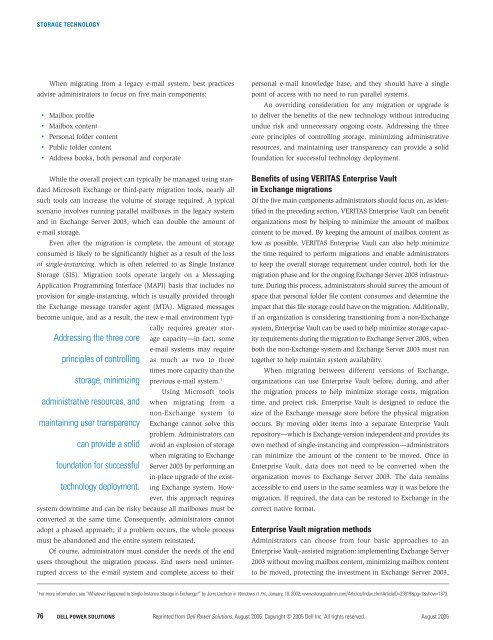POWER SOLUTIONS
POWER SOLUTIONS
POWER SOLUTIONS
You also want an ePaper? Increase the reach of your titles
YUMPU automatically turns print PDFs into web optimized ePapers that Google loves.
STORAGE TECHNOLOGYWhen migrating from a legacy e-mail system, best practicesadvise administrators to focus on five main components:• Mailbox profile• Mailbox content• Personal folder content• Public folder content• Address books, both personal and corporateWhile the overall project can typically be managed using standardMicrosoft Exchange or third-party migration tools, nearly allsuch tools can increase the volume of storage required. A typicalscenario involves running parallel mailboxes in the legacy systemand in Exchange Server 2003, which can double the amount ofe-mail storage.Even after the migration is complete, the amount of storageconsumed is likely to be significantly higher as a result of the lossof single-instancing, g which is often referred to as Single InstanceStorage (SIS). Migration tools operate largely on a MessagingApplication Programming Interface (MAPI) basis that includes noprovision for single-instancing, which is usually provided throughthe Exchange message transfer agent (MTA). Migrated messagesAddressing the three coreprinciples of controllingstorage, minimizingadministrative resources, andmaintaining user transparencycan provide a solidfoundation for successfultechnology deployment.become unique, and as a result, the new e-mail environment typicallyrequires greater storagecapacity—in fact, somee-mail systems may requireas much as two to threetimes more capacity than theprevious e-mail system. 1Using Microsoft toolswhen migrating from anon-Exchange system toExchange cannot solve thisproblem. Administrators canavoid an explosion of storagewhen migrating to ExchangeServer 2003 by performing anin-place upgrade of the existingExchange system. However,this approach requiressystem downtime and can be risky because all mailboxes must beconverted at the same time. Consequently, administrators cannotadopt a phased approach; if a problem occurs, the whole processmust be abandoned and the entire system reinstated.Of course, administrators must consider the needs of the endusers throughout the migration process. End users need uninterruptedaccess to the e-mail system and complete access to theirpersonal e-mail knowledge base, and they should have a singlepoint of access with no need to run parallel systems.An overriding consideration for any migration or upgrade isto deliver the benefits of the new technology without introducingundue risk and unnecessary ongoing costs. Addressing the threecore principles of controlling storage, minimizing administrativeresources, and maintaining user transparency can provide a solidfoundation for successful technology deployment.Benefits of using VERITAS Enterprise Vaultin Exchange migrationsOf the five main components administrators should focus on, as identifiedin the preceding section, VERITAS Enterprise Vault can benefitorganizations most by helping to minimize the amount of mailboxcontent to be moved. By keeping the amount of mailbox content aslow as possible, VERITAS Enterprise Vault can also help minimizethe time required to perform migrations and enable administratorsto keep the overall storage requirement under control, both for themigration phase and for the ongoing Exchange Server 2003 infrastruc-ture. During this process, administrators should survey the amount ofspace that personal folder file content consumes and determine theimpact that this file storage could have on the migration. Additionally,if an organization is considering transitioning from a non-Exchangesystem, Enterprise Vault can be used to help minimize storage capacityrequirements during the migration to Exchange Server 2003, whenboth the non-Exchange system and Exchange Server 2003 must runtogether to help maintain system availability.When migrating between different versions of Exchange,organizations can use Enterprise Vault before, during, and afterthe migration process to help minimize storage costs, migrationtime, and project risk. Enterprise Vault is designed to reduce thesize of the Exchange message store before the physical migrationoccurs. By moving older items into a separate Enterprise Vaultrepository—which is Exchange-version independent and provides itsown method of single-instancing and compression—administratorscan minimize the amount of the content to be moved. Once inEnterprise Vault, data does not need to be converted when theorganization moves to Exchange Server 2003. The data remainsaccessible to end users in the same seamless way it was before themigration. If required, the data can be restored to Exchange in thecorrect native format.Enterprise Vault migration methodsAdministrators can choose from four basic approaches to anEnterprise Vault–assisted migration: implementing Exchange Server2003 without moving mailbox content, minimizing mailbox contentto be moved, protecting the investment in Exchange Server 2003,1For more information, see “Whatever Happened to Single-Instance Storage in Exchange?” by Jerry Cochran in Windows IT Pro,January, 18, 2002; www.storageadmin.com/Articles/Index.cfm?ArticleID=23819&pg=1&show=1373.76DELL <strong>POWER</strong> <strong>SOLUTIONS</strong> Reprinted from Dell Power Solutions, August 2005. Copyright © 2005 Dell Inc. All rights reserved. August 2005








